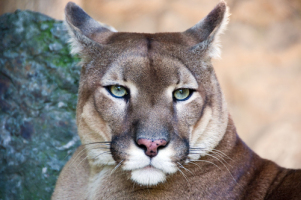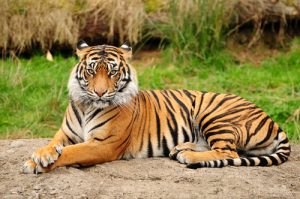By: C.A. Victor
From the cuddliest house cat to the King of the Jungle, felids are everywhere. They are regal, aloof animals that have a reputation for their fierce hunting instincts, as well as their distinctive appearance – no matter
the size of the species, all felids, look surprisingly similar. Felids – or cats as you might know them better – hold an important niche in maintaining balance in the ecosystem.
So let’s explore the history, characteristics, and general role that felids play in both the wild and domesticity.

What kind of animals are felids?
Felids are placental mammals belonging to the family Felidae. They are part of the order Carnivora, which includes many other carnivorous (or meat-eating) species. Colloquially, they are known as cats. For scientists, the word “cat” refers to both felids in general as well as the domestic cat (Felis cattus). While we use the word “feline” interchangeably with cat, “feline” is a descriptor meaning “similar to” or “like a cat.”
All members of the Felidae family share the same traits as all placental mammals: they are warm-blooded, they have special mammary glands that produce milk for nourishing their young, they are covered in hair, and bear live young.

What are the defining characteristics of felids?
Cats are predatory hunting mammals characterized by being obligate carnivores (they only eat meat), lithe and flexible bodies, rounded heads with large eyes, and distinctive upright ears. With keen senses, strong forelegs, and a powerful bite, they are among the best predators in the animal kingdom. They have whiskers – or tactile hairs – on their cheeks and forehead that help with navigation in dark or tight spaces as well as offering sensory input from their environments similar to an insect’s antenna. No matter what their size, they all share the same general body shape. Large felids look like larger versions of the smaller
species. Other characteristics include:
Retractable Claws. One defining feature of all felids, no matter the species, is their retractable claws. Their claws are attached to the terminal (end) bones of each toe with ligaments and tendons. Felids can actively
protract their claws by flexing muscles in their toes and passively retract them when not using them to hunt, catch prey, or climb. With the notable exception of cheetahs, their claws are protected by cutaneous
sheaths when not in use.
Digitigrade Locomotion. Felids are digitigrade, meaning they stand and walk exclusively on their toes, keeping their wrists and heels permanently raised. This contrasts with humans, for example, who walk on both their toes and metatarsals (the long bones in your feet). Most digitigrade animals can walk or run much faster than other animals (including humans).
Generally Solitary & Nocturnal. Most members of Felidae are nocturnal, hunting at night and generally resting during the day. They are also solitary. Unlike canines, they do not typically form family groups or hunt together unless it is a mother with her young. Typically, two members of a species will come together only for mating purposes. The notable exception to this is, of course, with lions who form a “pride” around one male and multiple females of the species.
Long Tails. Many – but not all – felid species have long tails that they use for balance for jumping, climbing, and when chasing after prey. Their tails are used for communication between others in their species as well.

What animals are in the Felidae family?
All cats belong in Felidae. Living species of the Felidae family can be split into two subfamilies: Pantherinae and Felinae. Originally, there was a third family (Acinonyx) but that was later absorbed as a genus-group within Felinae instead. To date, there is only one species of Acinonyx living – the cheetah.
Pantherinae.
This subfamily includes most of the “big” cat species most people are familiar with. However, what sets them apart from Felinae is a variation in the hyoid bone. The hyoid is in the throat near the larynx. When
that bone is not fully ossified (hardened), it is more flexible, and – combined with a specialized stretchy ligament in their voice boxes- these cats are capable of making a deep roar.
There are six members in the Pantherinae subfamily. They are the jaguar, leopard, lion, tiger, snow leopard, and clouded leopard.
Felinae.
All other currently living species of felids fall into this group. Except for the cheetah, these are mostly smaller species. The cats in this group have a fully ossified (hardened) hyoid bone. With the combination of this bony hyoid and shortened vocal folds in their voicebox, Felinae species are capable of purring but not roaring. Cat species can only do one or the other. Members of this subfamily include cheetahs, caracals, ocelots, lynxes, servals, cougars, bobcats, Palla’s cat, and others! Most importantly, this family
also includes the domesticated cat.
How did cats become domesticated?
Domestic cats are one of the most popular pets in the entire world. Archaeologists have found evidence of domesticated cats in Ancient Egypt at least 5,000 years ago. Viewed as god-like and often mummified
after death, cats provided the first line of defense against a common menace: rats. They were commonly used as pest control.
Because cats followed rodent populations, they quickly came into contact with human civilizations. These wild cats likely made the first approach and were subsequently domesticated along the way. In short, it is
believed that cats domesticated themselves.

Fun Facts About Felids
• Cat tongues are covered with horny papillae (small, rough bumps), which rasp meat from prey and aid in grooming.
• Of all the big cat species, only the cheetah is capable of purring.
• On the other hand, only four species of cats are capable of roaring: lions, tigers, leopards, and jaguars.
• Male lions are the only cats with manes (the growth of hair on the back of the head and neck).
• The domestic cat is the only feline that can hold its tail in a vertical position while walking. Wild cats hold their tails horizontally or tucked between their legs.
• Snow leopards have the longest tails of all the big cats. Their tails can be 90% the length of their bodies!
